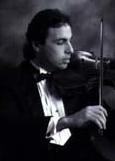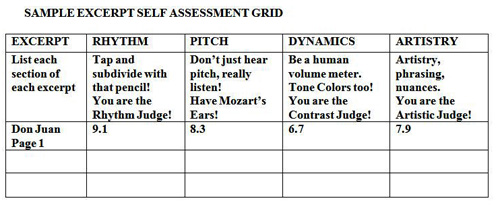Audition Mastery Guide
EXCEPTIONAL EXCERPTS
Too often, audition takers find themselves focusing on their solo pieces for auditions in a way that is out of proportion to the total task at hand. When auditioning for an orchestral position, remember that the committee is most interested in a poised, polished, team player. This is not to say that you should play your music as an android. However, during your audition preparation you should keep in the forefront of your mind that excerpts are the measuring stick that the committee uses to look for very specific musical skills and presentation characteristics.
One of the most helpful preparation tools is recording your excerpts! You should record yourself every three days or so. Remember, even a cheap little cassette recorder can help you immensely. There is really no need to go to a recording studio. After recording your excerpts, with your instrument in the case, be your own best audition committee. Be armed with a pad and paper and use the grid below as a guide. Listen to your recording of each selection 4 times. Each listening should be as if you are monitoring an Olympic event. You can even use a system of 9.9, 9.8 and treat this armchair assessment as a game, in a way. If you listen with a sense of humor, you will make a more accurate assessment of your level of preparation. Be cautious not to berate yourself to the point of being unfair to the overall picture of your preparation. No one but you needs to see your self assessment. By doing repeated recording sessions, you can track and direct your practice time and find that, too often, people play what they can already play well and most of the time, the “difficult spots” have some type of disclaimer built into their preparation. Needless to say, this is not good! So try to keep you sense of humor and be fair!
When playing your recordings of excerpts, you can do many things in order to try to “mentally create” an audition situation. Some people have been known to hang up a trash bag from the ceiling, using this as a pretend screen. Others go into the bathroom, not for just an echo-effect of pretend-concert hall, acoustical simulation, but to face the shower curtain as if it actually is an audition screen. You can even walk into the room as if you are walking out on stage. You can go through the routine of wearing the clothes you plan on wearing at the real audition.
Your imagination can be your best training tool!
After listening to your excerpts four times, with your most honest, fair and critical ears on, you will most certainly have learned much about what will come across to the real committee. It often is hard to translate music into a math score, and there is often much room for personal preference amongst the committee as a whole. You should step back from the practice time on your instrument and come up with a plan to improve the above numbers for the next self-assessment recording.
Remembering that you are human is incredibly important as you move forward with your practice sessions. Each practice session should have a defined set of goals and purpose. It is best to feel as though you are going back to the product-improvement department and not back to the drawing board. Remember to make note of what is working, as well as of what needs improvement. Be aware that you do not want to “practice in,” insecurity, but rather, that you are doing isolated training to improve your success.
ISOLATION IS KEY!
Just as you listened to your excepts in a category- based way, you should work on each aspect of your excerpts in an organized way. Here are techniques that work!
RHYTHM TRAINING TIPS
For building speed and accuracy in fast continuous passages, practice clearly- defined measures under tempo altering the rhythm from steady straight sixteenth notes to dotted sixteenth, followed by a snapped quick thirty-second note pattern.
(long-short, long- short) then reverse this pattern, (short-long, short-long).
Another way to solidify a set of four sixteenth- note patterns is to play the first note as an eight-note and then three even sixteenth- note triplets.
(eighth- tri-pu-let), and then reverse this pattern (tri-pu-let -eighth)
Then go back to playing steady sixteenth notes and, with the metronome, use the following tempo-solidity grid as a model.
When building speed on quick passages it is import to have phrasing landmarks in order to group your preparation into small attainable goals. Isolate the tricky or awkward spots, as if preparing each square in a quilt. Then play backwards by beat using five note patterns, and “sew” the quilt together.
Often people hit a speed wall where the passage fails to feel consistently comfortable and accurate. Instead of working yourself up to a frenzy, with the metronome going incrementally up a click until you hit this wall, try the following extremely helpful technique.
UP THREE, BACK TWO
If your goal tempo is Quarter Note= 120, start at 60 and then go up three clicks. It may seem, this has you start at a turtle pace but it will solidify rhythm and pitch accuracy. When you go up three clicks on the metronome, it forces you to go faster. Remember, each time you go faster, should trigger an equal smaller bow stroke and less effort from the larger muscles. Stay loose and minimize your motion. Then, do the passage again, going back two clicks from the faster tempo. This adds consistent solidity to the passage. Be aware of phrasing during the back-two-click playing with the metronome. Keeping this process of going up three and then back two clicks, up to and beyond your goal tempo, will raise your success rate and comfort level thousands of times more successfully then going up by click and maybe “hitting the wall.”
Another tip is to put the tempo that is one-half of your goal tempo on the metronome. Play the excerpt feeling it as if it is in cut-time. Instead of feeling the driving pace of every beat, you will feel a half speed undercurrent for the excerpt. This will have you playing at the goal tempo with a more relaxed flow of the music. You will be amazed!
PITCH SOLIDIFYING TIPS
At this stage of your musical development, you have become more than aware of intonation and how imperative that it be solid and consistent. Most of the time, intonation issues lie deeply rooted in technical deficiencies. You may wish to video tape your performance and watch this as well, in order to check that what you are doing is what you really know is the correct way to perform each task. Most often it is the transitions that cause intonation woes. Is there a shift that needs to be isolated? Of course, there is, or why would some of these excerpts be on the audition list? Practice your shifts at all varied speeds. Then do them backwards. Be certain of where your hand, body and mind need to be, to be successful in the shifted to position, and then shift to the note that proceeds it. Doing this, in one specific practice session, will save you hours of time, while increasing your consistency rate beyond imagination! Analyze and Address!
YOU ARE PROGRAMMING YOUR PERFORMANCE!
DYNAMIC CONTRAST TIPS
It may seem very artificial to be a human volume-meter. However, it is crucial to display to the committee that you have mastered every crescendo, articulation, and stylistic characteristic of each excerpt. You should listen to how your excerpt fits into the entire mix of the piece of music, being aware of traditional breath marks, bow strokes, and rubato expectations.
Consider making additional practice copies of your excerpts, which you can color code. One basic dynamic contrast color coding system is listed below:
DYNAMIC COLOR CODE
Piano and Pianissimo – BLUE
Mezzo Forte – GREEN
Forte and Fortissimo – RED
Use the color of the dynamic at which you are arriving at when making crescendos and decrescendos. Be creative and tailor-make your own color code. This visual display of the dynamic scheme will engrave a visual map of your dynamic contrast plan and solidify your total preparation.
ARTISTIC IMPROVEMENT TIPS
Did you grunt?, Gasp for Air?, Sniff on rests too audibly?
Well you may not have been aware of these extra-musical sounds.
You can play everything perfectly and still sound nervous or out of control! You can also check your facial expressions if you use a video recording for preparation as well.
It is a better method to plan your physical breathing, beyond musical phrasing, then letting whatever happens take place. It even is possible that you may be holding your breath during active tricky spots. Needless to say, if you do this, it is unintentional. We all need oxygen to keep our muscles nourished and relaxed, especially when they are being taxed. You can play like the finest concert artist, but if you faint at the audition, this may make your overall artistry points suffer a tad. In all seriousness, plan your breathing, know when to concentrate on keeping your shoulders down, or loosening your thumb. You can train your body to feel relaxed, instead of letting your body dictate your comfort level. Comfort can be learned!
Be in the flow! When playing your excerpts do not wait to the first note to start feeling the rhythm flow. You should think at least one full preparatory measure. This allows you to be in a “groove” before you make a sound. Feel as though you are your own conductor!
YOU ARE IN CONTROL OF YOUR PREPARATION!
From Adam Crane’s
Audition Mastery Guide
Available for purchase $12.95 or download $9.95 at www.craneclassical.com
©CCMS 2006 Reg. #TX-324-377




No comments yet.
Add your comment